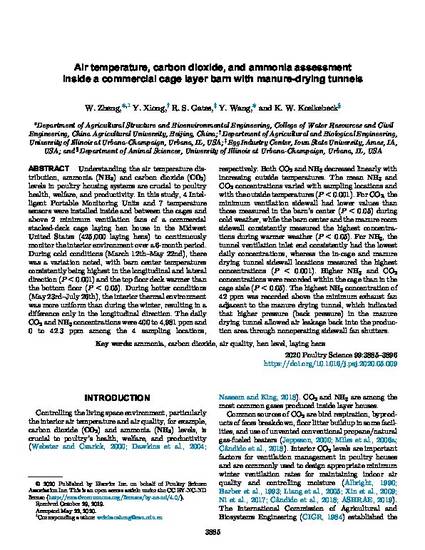
Understanding the air temperature distribution, ammonia (NH3) and carbon dioxide (CO2) levels in poultry housing systems are crucial to poultry health, welfare, and productivity. In this study, 4 Intelligent Portable Monitoring Units and 7 temperature sensors were installed inside and between the cages and above 2 minimum ventilation fans of a commercial stacked-deck cage laying hen house in the Midwest United States (425,000 laying hens) to continuously monitor the interior environment over a 6-month period. During cold conditions (March 12th–May 22nd), there was a variation noted, with barn center temperatures consistently being highest in the longitudinal and lateral direction (P < 0.001) and the top floor deck warmer than the bottom floor (P < 0.05). During hotter conditions (May 23rd–July 26th), the interior thermal environment was more uniform than during the winter, resulting in a difference only in the longitudinal direction. The daily CO2 and NH3 concentrations were 400 to 4,981 ppm and 0 to 42.3 ppm among the 4 sampling locations, respectively. Both CO2 and NH3 decreased linearly with increasing outside temperatures. The mean NH3 and CO2 concentrations varied with sampling locations and with the outside temperatures (P < 0.001). For CO2, the minimum ventilation sidewall had lower values than those measured in the barn’s center (P < 0.05) during cold weather, while the barn center and the manure room sidewall consistently measured the highest concentrations during warmer weather (P < 0.05). For NH3, the tunnel ventilation inlet end consistently had the lowest daily concentrations, whereas the in-cage and manure drying tunnel sidewall locations measured the highest concentrations (P < 0.001). Higher NH3 and CO2 concentrations were recorded within the cage than in the cage aisle (P < 0.05). The highest NH3 concentration of 42 ppm was recorded above the minimum exhaust fan adjacent to the manure drying tunnel, which indicated that higher pressure (back pressure) in the manure drying tunnel allowed air leakage back into the production area through nonoperating sidewall fan shutters.
Available at: http://works.bepress.com/richard-gates/73/

This article is published as Zheng, W., Y. Xiong, Richard S. Gates, Y. Wang, and K. W. Koelkebeck. "Air temperature, carbon dioxide, and ammonia assessment inside a commercial cage layer barn with manure-drying tunnels." Poultry science 99, no. 8 (2020): 3885-3896. doi: 10.1016/j.psj.2020.05.009.